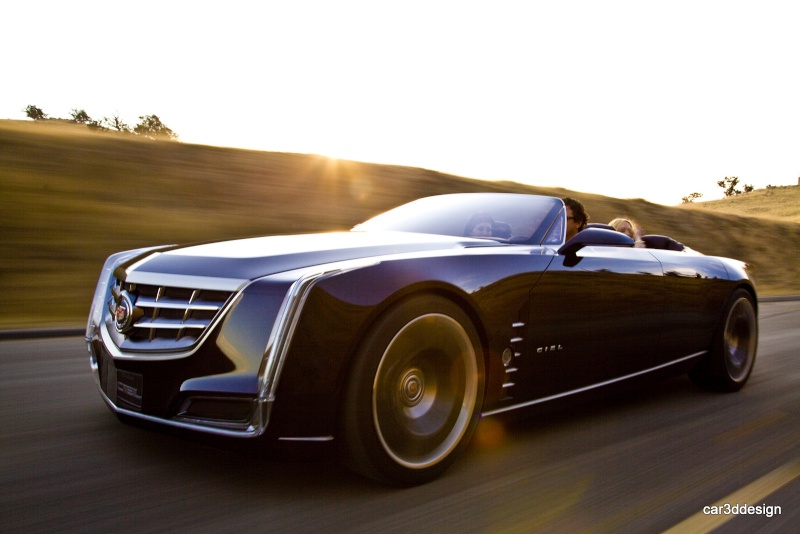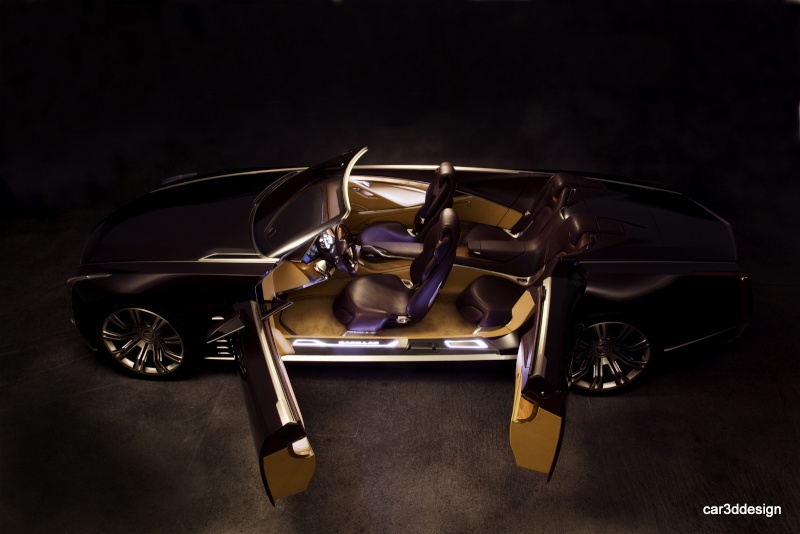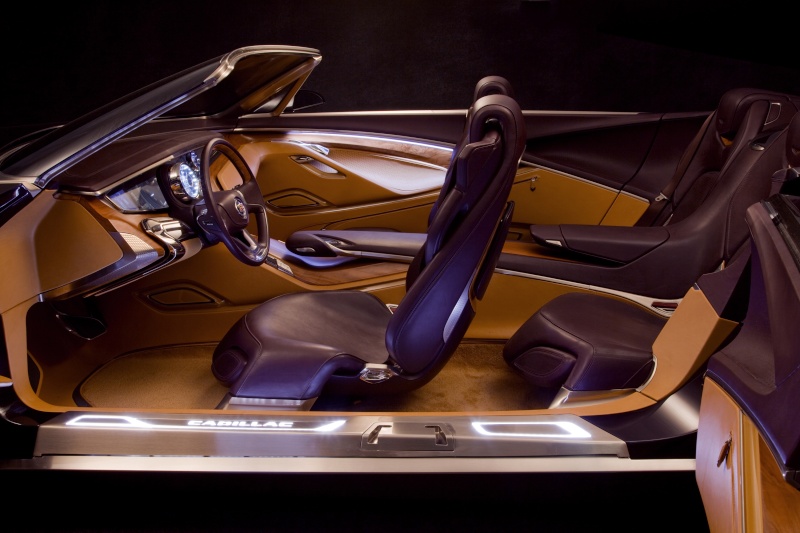-
Par stef V le 20 Août 2011 à 16:21
<script type="text/javascript"> </script><script type="text/javascript" src="http://pagead2.googlesyndication.com/pagead/show_ads.js"> </script><script type="text/javascript"> </script><script type="text/javascript" src="http://pagead2.googlesyndication.com/pagead/show_ads.js"> </script><script type="text/javascript"> </script><script type="text/javascript" src="http://pagead2.googlesyndication.com/pagead/show_ads.js"> </script>


















Cadillac today unveiled the Ciel concept, an elegant, open-air grand-touring car inspired by the natural beauty of the California coast.
The Ciel – pronounced “C-L,” the French translation for sky – is a four-seat convertible that opens a new chapter in Cadillac’s design and product ascent, pushing the brand’s Art & Science philosophy into a new stratum. Ciel is a new expression of Cadillac’s historical grandeur, as well as a celebration of open-air motoring.
“Large, expressive luxury is innate to Cadillac and the Ciel recalls that heritage, while suggesting where the brand can go in the future,” said Clay Dean, global design director for Cadillac. “Authentic luxury is driven by experiences, not just products, and Ciel is about the experience of the journey.”
The spacious and elegant Ciel is a grand gesture that explores themes driving Cadillac’s explorations into range-topping flagship luxury. It is powered by a twin-turbocharged version of the 3.6-liter Direct Injection V-6 engine, paired with a hybrid system using lithium-ion battery technology.
Coastal inspiration
Driving California’s Highway 1 in an open car while the sun sets, from Big Sur north to Monterey, is the type of journey the Ciel team envisioned during its design.
“The Ciel is about the romance of the drive,” said Dean. “It emulates the great touring cars seen on the greens at Pebble Beach, but with a modern flair that projects Cadillac’s vision for the future.”
The four-door Ciel embraces the social aspects of a recreational journey, with generous room for two couples. It evokes the spirit of the classics with a long, low proportion. The doors are French-style, with the rear doors hinged at the rear – there is no B-pillar – to reveal a sweeping view of the dramatic interior. Distinguishing fender lines run from nose to tail, and nickel-plated bright work accents the body lines, enhancing the visual length of the car and honoring Cadillac touring cars of the past.
Ciel’s exterior flows seamlessly into the cabin, with the body color rolling over on top of the interior door panels. Like the exterior, the passenger space is accented with sweeping nickel-plated trim. It divides the body-color upper sections from a complementing beige lower color. Italian Olive wood, machined aluminum and hand-tipped leather are elements that flow through the interior, complementing the primary colors with warm, rich tones.
“There is authentic craftsmanship in the way the exterior and interior elements meld, much like a vintage wooden boat,” said Gael Buzyn, interior design manager. “It is romantic, not only in its form, but the materials – nothing smells as good as real wood and leather. It blends together for a rewarding feeling of uncompromising luxury.”
Ciel literally and figuratively reflects the driving experience along the California coastline. The Cabernet paint color, developed specifically for Ciel, is inspired by the rich translucence of a glass of red wine held up to the sunlight.
A prominent, polished aluminum windshield frame serves as in important structural element of the vehicle, as well as aesthetic one, recalling classic open cars of the past. Additional exterior cues, including a shield grille and vertical lighting elements, are pure Cadillac, but suggest a more organic interpretation of the brand’s signature design language that emphasizes the artistic and natural sides of it. The body sides, for example, are more rounded, sweeping upward. Bright work is used to bring contrast to the deep paint color, but plays a more supporting role.
The car rides on large, beautifully finished wheels that feature brushed nickel plating over milled billet aluminum, matching the materials and appearance of other trim. Carbon ceramic brake rotors are visible behind the 22-inch rims, a visual clue to the Ciel’s foundation of performance.
And owing to Cadillac’s heritage of advanced technology, the headlamps and taillamps feature LED lighting elements – including a unique daytime running light graphic on the front of the vehicle that is generated with gradated LED lighting.
Elegant, authentic details
Simplicity, authenticity and spaciousness were the guiding principles when it came to developing the Ciel’s interior.
“With the Ciel, the journey is the thing, so the interior is a place of uncompromising comfort and elegance, with technology that only makes the journey more enjoyable,” said Buzyn. “Simplicity and lightness ensure nothing distracts from the open driving experience, while the color and materials lend the feeling that the vehicle’s environment blends with the surroundings.”
A wheelbase of 125 inches – about 12 inches longer than a CTS sedan – provides generous space. Luxurious seats are bisected by a “floating” center console that runs from the instrument panel to the rear of the interior. It effectively creates a very personal space for each passenger and houses access to hidden connectivity portals for each person in the vehicle – allowing them to make dinner reservations, check the weather at their destination or even upload photos of the trip via social media sights.
Simplicity is also the watchword with the Ciel’s instrument panel, which features a minimalist gauge cluster that doesn’t impede or distract from the outward view. But while reserved in its form, it exemplifies Cadillac’s attention to details and its priority on authentic materials. The climate vents, for example, are mostly hidden and their airflow is distributed indirectly.
Transparent gauges deliver their information within a detailed, brushed-aluminum housing that has the intricate depth of a high-quality chronograph. They offer dual readouts – analog and digital – as well as an information hierarchy. Additional interior features include:
- Sloping bolsters on the seats that allow passengers to slide into the seats more comfortably
- A personal device storage area on the front of the console with inductive charging and Bluetooth connectivity
- A power-assisted transmission shifter that deploys as soon as the engine is started
- Lighting in the armrests that combines a natural light well for daytime driving and ambient lighting for nighttime drives
- Door storage areas that are inspired by premium fashion accessories and open with high-quality zippers
- Pull-out blankets are available for all three passengers and retract automatically
- All the seats have heating and cooling features, along with a drawer containing sun lotion, sun glasses and towels, as well as aromatherapy that is controlled from the rear armrest.
But perhaps the defining element of the Ciel’s cabin is the incorporation of Italian Olive wood on the doors, instrument panel, console and the front seatbacks, adding warmth and craftsmanship to a car designed to provoke an emotional response.
“Milled solid wood delivers richness and a sensual feeling of authenticity in the visual impact of the grain, its feel and aroma, which a veneer simply cannot,” said Buzyn. “Even in our high-tech, connected world, luxury customers crave touches of old-world craftsmanship – the Ciel simply reflects that with a blend of the latest technology.”
Italian Olive wood is a premium yet sustainable material and the material used in the Ciel came from a single fallen and recycled tree, from a west coast producer of premium olive oil. It was painstakingly prepared, including drying in a kiln, before it was cut for the concept vehicle. The numerous pieces were then photographed so that the grain could be matched precisely. Each component was hand-milled and finished by expert woodworking craftsmen.
The rear seating area is detailed with elegant flourishes. The rear seat passengers can pull a leather tab, which reveals a cashmere blanket that stretches across the seating area to ward off a chill. The wood trim in the rear center console opens to reveal a small humidor, stocked with a few cigars.
“From the materials used to create it to the space and experience it offers passengers, the Ciel represents a unique perspective on luxury, but not the only one,” said Dean. “Along with other concepts, such as the ULC, Cadillac is demonstrating that the bandwidth of the Art & Science philosophy is wide, indeed – and we’re going to make it even wider.”
The Ciel was developed at GM Design’s North Hollywood Design Center, which is managed by Frank Saucedo. Niki Smart was the lead exterior designer, with Buzyn leading interior development.
About Cadillac
Cadillac has been a leading luxury auto brand since 1902. In recent years, Cadillac has engineered a historic renaissance led by artful engineering and advanced technology. More information on Cadillac can be found at media.cadillac.com.
SPECIFICATIONS
Vehicle:
Cadillac Ciel concept
Body style / driveline:
four-door, four-passenger convertible with longitudinally mounted front engine and all-wheel drive
Wheelbase (in / mm):
125 / 3175
Length (in / mm):
203.7 / 5174
Width (in / mm):
77.5 / 1968
Height (in / mm):
50 / 1270
Engine type:
3.6L V-6 with twin turbochargers; DOHC, continuously variable valve timing and direct injection
Horsepower
(hp / kW):425 / 317
Torque (lb-ft / Nm):
430 / 583
Transmission:
hybrid with low-speed all-electric drive
Front suspension:
independent SLA with monotube shock absorbers and stabilizer bar
Rear suspension:
independent multilink with monotube shock absorbers and stabilizer bar
Brakes:
four-wheel disc with ABS; vented front rotors with six-piston calipers and solid rear rotors with four-piston calipers
Wheel size and type:
22 x 9-inch aluminum with brushed nickel accents
Tire size:
265/35R22
 votre commentaire
votre commentaire
-
Par stef V le 11 Janvier 2009 à 22:21












Le concept CADILLAC CONVERJ est construit sur la base technique de la Chevrolet Volt. Le CONVERJ est donc un véhicule hybrique .Association d'un moteur electrique de 120KW developpant 370Nm et un moteur thermique 4 cylindres fonctionnant au bio-éthanol assurant une autonomie supérieure aux 40 miles (64 km env.) en mode tout électrique
CONVERJ: THE “CADILLAC” OF ELECTRIC VEHICLES
<script type="text/javascript"></script> <script src="http://pagead2.googlesyndication.com/pagead/show_ads.js" type="text/javascript"></script> <script type="text/javascript"></script> <script src="http://pagead2.googlesyndication.com/pagead/show_ads.js" type="text/javascript"></script> <script type="text/javascript"></script> <script src="http://pagead2.googlesyndication.com/pagead/show_ads.js" type="text/javascript"></script>
Luxury coupe concept continues GM’s leadership in the electrification of the automobile
General Motors unveiled a further glimpse at the potential of electric propulsion today, this time in the form of luxury transportation, with the Cadillac Converj Concept. The Cadillac Converj was developed as a well-appointed grand touring coupe with a bold design and a host of interactive technology.
The four-passenger Converj concept is intended to show how GM’s revolutionary electric propulsion technology – called Voltec – can power a luxury coupe with a typically Cadillac “no compromises” design. The technology enables up to 40 miles of gas- and emissions-free electric driving with extended-range capability of hundreds of miles.
Bob Lutz, GM's vice chairman of Global Product Development, said the Converj concept has production substance. “It’s a logical extension of our plan to reinvent the automobile,” he said. “It clearly shows what a Cadillac electric vehicle could look like, and clearly indicates that global luxury customers can have a car that has both strong design and electric propulsion with a total range of hundreds of anxiety-free miles.”
Cadillac’s extended-range electric vehicle (E-REV) concept has a new body style that is an evolution of the brand’s traditional Art and Science design theme. An aggressive, forward-leaning arc profile is the foundation for the sporting stance. And more than a Cadillac in form, Converj is also intended to be a Cadillac in substance, with the premium materials, technology and driving dynamics that are hallmarks of the brand.
Voltec – innovative propulsion technology
The Cadillac Converj’s Voltec electric propulsion system is made up of a 16-kWh, T-shaped battery, an electric drive unit, and a four-cylinder engine-generator. It uses electricity as its primary source to drive the car.
A thermally managed battery pack contains more than 220 lithium-ion cells that provide the primary power to drive the Converj electrically up to 40 miles without using fuel or producing tailpipe emissions. The battery is integrated into the Converj’s chassis and stores electricity from the grid when the vehicle is plugged in. It takes less than three hours to recharge the battery at 240V, or about eight hours from a 120V outlet.
When the battery’s energy is low, the Converj seamlessly switches to extended-range mode. During this secondary level of operation, electricity needed to power the vehicle is created on-board by a flex-fuel-powered engine that operates much like a home generator to create electricity. The engine-generator ensures a constant supply of power for hundreds of miles until the car is refueled or plugged in to recharge the battery. This extended-range mode eliminates the range anxiety that comes with driving pure electric vehicles that offer no backup power when the battery charge is low.
Whether in electric or extended-range mode, the Converj is propelled all the time by an electric drive unit. It converts electrical energy from the battery or the engine-generator into mechanical energy to drive the front wheels. It also delivers 273 lb.-ft. (370 Nm) of instant torque, for a quick launch, and 120 kW of power. The top speed is 100 mph.
There is no compromise in vehicle performance in either mode of operation. To enhance the ride feel, the Converj also features GM’s Magnetic Ride Control; and for even greater efficiency, energy during braking is captured and stored in the battery.
Pure Cadillac design
There’s no mistaking the Converj for anything but a Cadillac, according to Lutz. “An aggressive, forward-leaning profile hints at a new, progressive theme and proportion in Cadillac’s design evolution,” he says. “The new proportion showcases a uniquely shaped, modern vision of a personal luxury 2+2.”
The overall shape is reinforced by a prominent, sweeping body line with large, 21-inch (front) and 22-inch (rear) wheels pushed to the edges of the body. The Converj exterior is painted a dark silver tri-coat that GM designers dubbed “Reaction.”
An all-glass roof incorporates solar panels that help offset power drain from the vehicle’s accessories. Additionally, several aerodynamic and design efficiencies were incorporated to enhance the driving range, including:
* A full under-vehicle cover (belly pan)
* Minimal grille openings that reduce drag at the front of the vehicle
* Low-profile rearview cameras replace conventional outside mirrors to reduce drag
* Wheels are shaped to push air outward for smoother body side airflow
The Converj also incorporates vertical headlamp and taillamp elements, with light pipe technology.
“Vertical lamps are Cadillac signatures and the Converj builds on the brand’s light pipe technology with bolder light emitting diode (LED) and high-intensity discharge elements front and rear,” said Clay Dean, global design director for Cadillac. “There is also a unique daylight light ‘spear’ at the top of the headlamps.”
Luxury meets technology inside
The Converj’s interior has advanced features and luxurious appointments blending efficiency and environmental consciousness. The 2+2 configuration is trimmed in contrasting Winter White synthetic suede – including the top of the instrument panel – and Midnight Black leather, with polished aluminum and wood grain accents. Renewable materials are used throughout such as wool-blend carpeting, a headliner made from silk, suede made from post-industrial content and more.
A technologically advanced driver center increases efficiency and reduces the draw on the battery. Features include:
* New, organic light-emitting diode technology used on reconfigurable instrument cluster
* Touch-screen navigation, climate, center-stack controls and audio systems
* Adjustable, overhead white ambient lighting
* Unique “power on” sequence featuring blue-lit console graphics
* Screen displays for features including regenerative braking, battery charge level and power output
* No inside rearview or outside mirrors; cameras provide surrounding images on a screen placed high on the instrument panel for a full, panoramic view
* Push-button ignition and power-folding front seats votre commentaire
votre commentaire Suivre le flux RSS des articles de cette rubrique
Suivre le flux RSS des articles de cette rubrique Suivre le flux RSS des commentaires de cette rubrique
Suivre le flux RSS des commentaires de cette rubrique
stephane-vaillant.com






